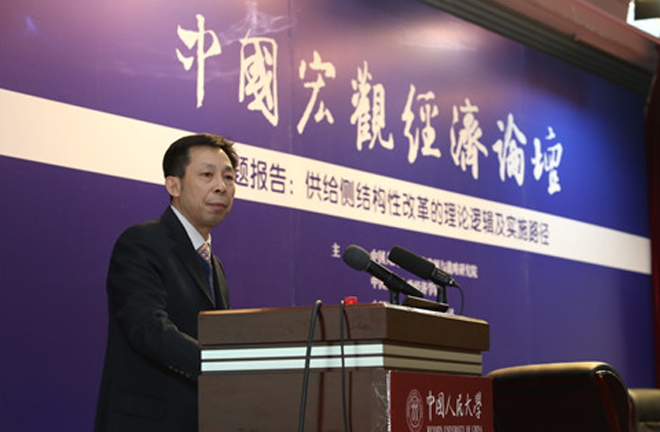Supply-side structural reform explored

The China Macroeconomic Forum was held on March 19 at Renmin University of China.
The theory and implementation of supply-side structural reform was the topic of debate at the China Macroeconomic Forum held on March 19 at Renmin University of China.
Scholars explained that the nation’s supply-side reform policy is often wrongly interpreted as being based on Western Supply-side Economics.
Guo Jie, an economics professor at Renmin University, said that the Western concept of Supply-side Economics simplifies and radicalizes the microeconomic and macroeconomic theories proposed by neoliberal economists in the 1970s, so the term is misleading.
Supply-side Economics was developed as a counterweight to Keynes’s demand-side management, and it is based on a restoration of Say’s law of markets, which holds that production is the source of demand. It was believed that supply will create demand automatically. However, demand-side factors have played a significant role in major economic crises, like the Great Depression and the ongoing global economic slowdown. From this viewpoint, Supply-side Economics is overgeneralized, Guo said.
The theoretical basis of supply-side structural reform is neither Supply-side Economics nor structuralism, much less neoliberalism. The policy applies, develops and innovates Marxism and political economics with Chinese characteristics in the context of the "new normal." Supply-side reform is a new stage in the development strategy of China’s economic work, Guo added.
“That ‘relations of production must conform to the level of productive forces’ is the logical starting point of supply-side structural reform. It aims to reform production relations that are not suited to the new normal, thereby boosting productivity,” Guo said.
Regarding the relationships connecting the new normal, the five development concepts of “innovation, coordination, greenness, openness and sharing” and supply-side structural reform, Zhang Xiaojing, deputy director of the National Laboratory of Finance and Development, pointed out the need to unite the concepts in a single framework.
“The new normal is a fundamental and overall notion that provides the basic context. The five development concepts offer guidance for ushering in and adapting to the new normal, and supply-side structural reform is the starting point and foothold for us to implement the five development concepts under the new normal,” Zhang said.
Supply-side restructuring is fundamentally about reform, said Huang Guitian, assistant to the president of Peking University, arguing that advancing comprehensive reform is critical to the long-term growth of China’s economy.
The reform of supply management is a key aspect, Huang said, adding that a crucial issue of supply-side reform is to further straighten out the relationship between government and the market.
Zhang said that the supply side should not be confined to producers that provide commodities and labor. Government is also a big provider. What the government can supply during supply-side reform is good governance, such as creating a fair, just environment for competition and innovation, a stable macroeconomic context, and institutional discourse power in global economic governance, he said.
With regard to the major direction of supply-side structural reform, the National Academy of Development Strategy at Renmin University put forward a few suggestions in a report titled “Theoretical Logic and Implementation Path of Supply-side Structural Reform,” which was released at the forum.
In the international arena, the different policies of the United States, Japan, Europe and emerging countries will present external opportunities for China’s structural adjustments. The report recommended capitalizing on the trend and seizing cost opportunities when trade in staple commodities is stagnant.
Moreover, cooperation with high-tech US enterprises should be strengthened to transfer intelligent manufacturing and climb up the global value chain. It is also important to actively participate in Europe’s infrastructure investment to export excess capacity of the energy and construction materials sectors, according to the report.
Cost reduction is at the core of supply-side adjustments. China’s supply-side structural reform cannot simply count on the factor market to reduce costs, according to the report.
Although the integration of the factor market can help lower costs, boost effective supply and propel structural adjustments within a short period, China’s total factor costs will necessarily rise as demographic dividends diminish and environmental constraints increase. Therefore, the short-term price decreases caused by the marketization of factor prices can hardly resist the long-term trend, according to the report.
The report suggested realizing economies of scale and scope as well as innovating on the supply side when factor prices go up. This is the only way to increase production efficiency and reduce costs when the offsetting factor price rises, thus enhancing supply quality and efficiency and accelerating restructuring, according to the report.
Mao Li is a reporter at the Chinese Social Sciences Today.
